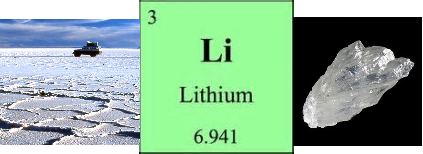Source: Geology.com
Source: Geology.com
The Manono and Kitotolo pegmatites, each 5.6 kilometres long and 45 to 790 metres wide, contain 10-25% spodumene. For the Kitotolo pegmatite Kesler (1978) reported reserves of 120,000 tonnes of ore containing 0.6% Li (contained Li of 720,000 tonnes) and an additional resource of 400 Mt of ore containing 0.6% Li for a contained Li of 2.4 Mt. More recently Clarke and Harben estimate that Manono contains 835,000 tonnes and Kitotolo contains 310,000 tonnes of lithium resources, for a total resource estimate of 1.145 Mt of lithium.
-
AVZ Minerals Ltd (AVZ:AU) holds interests in exploration projects prospective for lithium, tin, tantalum and associated minerals located in the Democratic Republic of Congo, including a 60% interest in the Manono Project a lithium-rich pegmatite deposit, 100% interest in the surrounding Manono Extension Project (lithium, tin, tantalum) and the Katanga Regional Project (lithium, base metals and rare earths). The Manono Project is owned by AVZ (60%), La Congolaise D’exploitation Miniere SA (30%) (Cominiere, a State-owned enterprise) and Dathomir Mining Ressources SARL (10%) (Dathomir, a privately owned company). The presence of lithium mineralisation in pegmatites at Manono has been confirmed to extend along strike of for more than 13km. Two large areas of pegmatite have been identified, with the northeast area, referred to as the Manono sector and the southwest area, referred to as the Kitotolo sector. Mapping within the two sectors has established that there are many pegmatites, representing separate intrusions, including six large pegmatites. The large pegmatites all contain spodumene mineralisation. The majority of the smaller pegmatites also contain spodumene and in some cases other lithium minerals. The two largest pegmatites (known as the Carriere de L’est Pegmatite and the Roche Dure Pegmatite) are each of similar size or larger than the Greenbushes Pegmatite in Western Australia. The thickness of the Roche Dure Pegmatite currently being drill tested is estimated to be at least 240 metres. Spodumene ranging between 5% to 25% of whole rock volume and minor cassiterite/coltan is clearly visible in sections of the core. The estimated base of weathering ranges between approximately 30 to 60 metres below surface with a short transitional zone and then fresh (unweathered) pegmatite below to a depth of at least 240 metres. AVZ’s current activities at Manono comprise mapping, surface trenching and diamond drilling. The Manono Extension Project comprises two granted exploration permits (PRs 4029 and 4030) covering 242.25km2 and surround the Manono Project licence. The Katanga Regional Project comprises seven exploration licences within the mid-Proterozoic Kibaran Belt in the south of the Democratic Republic of Congo known to host lithium bearing pegmatites. AVZ has reached an agreement with Huayou International Mining (HONGKONG) Limited (Huayou) for Huayou to invest $13.02 million and acquire an 11% interest in AVZ.
- TANTALEX Resources Corporation (CSE: TTX)(CSE: TTX.CN)(CNSX:TTX)(FRANKFURT: 1T0) is a mining company engaged in the acquisition, exploration, development and distribution of Lithium, Cobalt, Tantalum and other high-tech mineral properties in Africa. The Company is listed on the Canadian Stock Exchange and the Frankfurt Stock Exchange. Sandstone Worldwide Ltd., a wholly-owned subsidiary of Tantalex is currently engaged in a joint-venture with COMINIERE SA (70% Tantalex/30% COMINIERE) on their highly prospective Lithium Buckell property located in the Manono-Kitotolo area, a significant land package measuring over 1,000 km2 that is contiguous to the Manono-Kitotolo (MK) deposit. In fact, the MK deposit is the geological model upon which Tantalex has also based exploration of its Buckell Lithium project. In October of 2016, Tantalex reported the presence of Lithium, Tantalum, Niobium and Tin on their Buckell property, based on historical data obtained from COMINERE SA as well as property assays. (see NI43-101 Report issued January 25, 2017).



